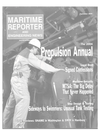
New Positioning Technique Helps Cut Costs in Deepwater GOM
During a recent 10-day project in the Gulf of Mexico for a major E&P company, the use of inertial navigation technology reportedly reduced vessel time by three to five days over the course of the deployment and positioning of seismic data acquisition modules. Prior to this sea-trial, precise underwater positioning was achieved by dropping and calibrating an array of acoustic beacons on the seabed - a timeconsuming process that requires deployment, calibration and later recovery of the beacons.
"A significant increase in productivity and reduced safety risk was achieved using the Kongsberg Maritime Hydroacoustic Aided Inertial Navigation (HAIN) system, while maintaining the accurate placement and positioning of the modules," said George Buhler.
Positioning & Navigation Consultant for C&C Technologies, one of three service providers on the project, together with Fairfield Industries and Sonsub. "The equipment was mounted on a remote operated vehicle (ROV) and was ready to work as soon as it arrived onsite. Furthermore, the positioning accuracies we achieved were comparable to those of traditional technologies throughout a range of water depths." By using an inertial system as the primary method for ROV navigation and positioning, the team determined that inertial technology can be used to replace an array of acoustic beacons as the primary source of navigation and positioning for a variety of seabed operations that require precise navigation and positioning. With fewer points of failure and a lower safety risk due to a significant reduction in back deck operations; this successful sea-trial was a first step in introducing this new technology to deepwater oil and gas ROV operations.
The seismic data acquisition modules were Fairfield Industries' Deep Z Pods, a self-contained, 4C recording sensor for Azimuth Long Offset, full-wave seismic data acquisition in deepwater. The project took place in water depths ranging from 4000 to 7000 feet using a Sonsub Innovator ROV deployed from the support vessel HOS Innovator.
Circle 11 on Reader Service Card
Other stories from September 2004 issue
Content
- SSI Concerns Continue page: 5
- Signed Confessions page: 9
- OMI to Pay $4.2M for Waste Oil Dumping page: 14
- NASSCO Delivers Alaskan Frontier page: 17
- Alabama Shipyard to Build Hopper Dredge page: 17
- Merwede Tapped for Navy, Commercial Contracts page: 18
- FBM Babcock Wins U.S. Contract page: 19
- New Vessels from VT Halmatic page: 19
- ABCO Launches Three New Boats page: 20
- IR Generates $64M in Orders page: 24
- Sideways to Swimmers: Unusual Tank Testing page: 26
- Current Uses of FEA in Shipbuilding page: 30
- BMT Aims to Improve Vessel Evac page: 32
- Flensburg Makes its Mark Again page: 36
- SMM 2004: Ready for the World page: 36
- German Shipyards Propose Merger page: 37
- Voith to Exhibit VWT Baut at SIMM page: 37
- Blohm + Voss Repair Wins Business page: 38
- Methane Arctic Benefits from German Technology page: 39
- Becker Kort Rudder Nozzles for Improved Maneuverability page: 40
- Payer Presented Cross of the Order of Merit page: 42
- Xantic: Focus on Integrated Solutions page: 44
- A Benchmark in Electronic Fuel Injection page: 45
- Q&A with Wartsila CTO Matti Kleimola page: 46
- Seacor Crewboats "Eliminators" Some Maintenance Costs page: 49
- (Fuel) Cells of Endeavor page: 50
- Containerships: When Will One Engine Not Be Enough? page: 52
- Most Powerful Common- Rail Engine Passes Test page: 54
- Clean Concept for Brostrom Tankers page: 54
- Canadian Towing Firm Refits for the Future page: 56
- TOR: The Next-Generation Turbocharger page: 57
- Duramax Marine Creates Largest Ever DuraCooler page: 58
- ABS: Large Ship Hull Deflections Impact the Shaft Alignment page: 60
- The Great Maritime Disruption... that Never Happened page: 66
- New Positioning Technique Helps Cut Costs in Deepwater GOM page: 76
- U.S. Ferry Market Prospects Looking Up page: 77
- "Ship Design and Construction" page: 81

